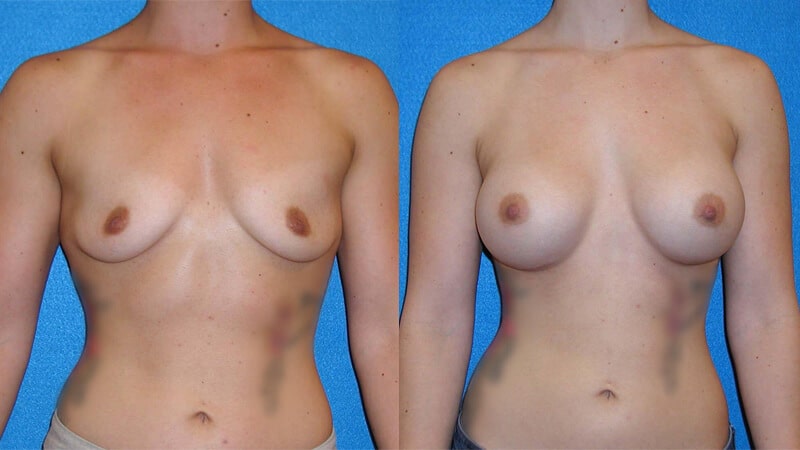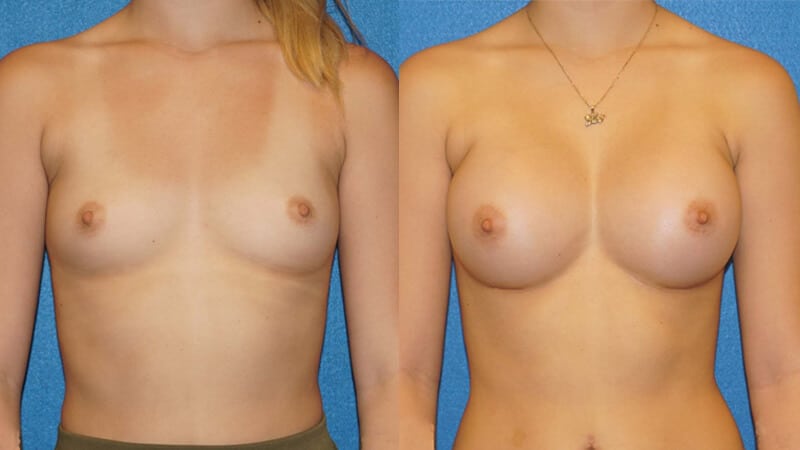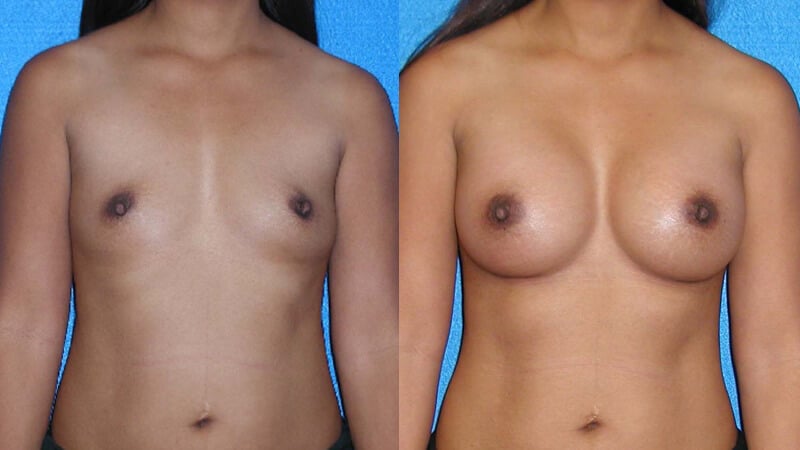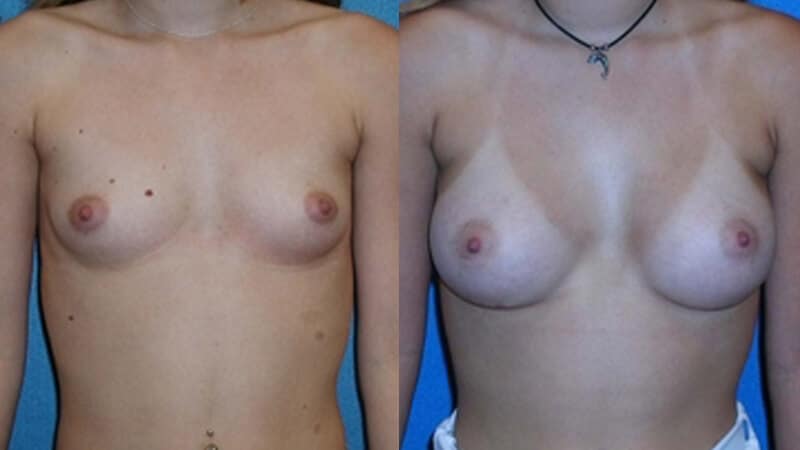Reasons to Consider Breast Enlargement
Customizable Breast Enlargement Options
There are endless possibilities with breast augmentation, but it takes a plastic surgeon with a keen eye for aesthetic beauty to devise a personalized surgical procedure tailored to the unique specifications for every patient. During a thorough consultation, Dr. Green will discuss all of the different approaches to breast augmentation that can address your needs.
Implant Composition
Shell
Both silicone and saline implants consist of a silicone shell encasing the filler product. The surface of the implant shell can be smooth or textured, depending on your personal preference.
- Smooth implants tend to feel more natural and have a thinner shell than textured implants. These implants are also less likely to produce visible rippling.
- Textured implants stay in position better than smooth implants and may be less likely to result in capsular contracture.
Filler
Breast implants are filled with one of two substances. Along with Dr. Green, a patient will weigh multiple factors in deciding which material is the right choice for her breast enlargement.
Silicone
Regarded as the filling type that both looks and feels more like natural breast tissue, silicone is the most popular breast implant option among breast augmentation patients. Their thicker density mimics human fat. They come in two shapes, round and teardrop, but teardrop implants are not used very frequently.
Complications associated with silicone breast implants are especially low, with minimal chances of an implant wrinkling, shifting out of place or rupturing. While the rupture rate is very low, because a silicone implant rupture is difficult to detect, patients are advised to undergo a mammogram or ultrasound five years after the implants are placed (and again every three years after that) to ensure that the implants remain in good shape.
Saline
Saline implants are filled with a sterile saltwater solution. Usually, they are less expensive than silicone implants, but they only come in one shape: round.
Typically, the incisions and subsequent scars are smaller with saline implants because they can put into the body empty and filled later. This allows for more choice in incision location, including the transaxillary (armpit) area. It is also possible to add or remove some solution to adjust the size to the patient’s precise preference.
Though implant ruptures uncommon with all implant types, in the event that a saline implant rips, it is easy to spot since the breast will start to look deflated.
Implant Qualities
Size
Breast implants are measured in cc’s (cubic centimeters) and are available in various sizes. Silicone implants are filled by the manufacturer, so the volume cannot be manipulated. By contrast, saline implants can be altered slightly during surgery for a fine-tuned result. Dr. Green will take your measurements during your consultation to determine which implant sizes will complement your body frame and create the bustline you desire.
Shape
The first breast implants were round. They remain the most popular choice among women seeking breasts with a fuller appearance. While all implants round out the bottom of the breasts, these implants round out the top of the breasts as well. They can be filled with either saline or silicone material.
Round implants are more successful at exaggerating the silhouette and enhancing cleavage for a more attractive presentation in clothing. Some women have found that round implants help to achieve a natural lifting effect.
Although teardrop implants were briefly popular, they are rarely used anymore because they are textured and carry an increased risk for ALCL (anaplastic large cell lymphoma). Compared to round implants, teardrop implants are more expensive and more likely to wrinkle and shift out of place.
Profile
Implant profile determines how far the implants protrude from the chest wall. Dr. Green typically suggests a type of profile that corresponds with the patient’s aesthetic goals and existing breast width.
- Low profile implants are the flattest and broadest. They are typically recommended to women with a wide chest frame.
- Moderate profile implants provide some forward projection on the breast while still looking natural. They work best on women with a medium frame who want decent projection.
- High profile implants are the narrowest implants. They offer more projection than the other options. They tend to look best on petite women with narrower breasts.
Implant Placement
Subglandular
Subglandular implant placement involves positioning the breast implants above the pectoral muscle but beneath the natural glandular breast tissue. The result is a shorter, more comfortable recovery period, and natural movement that is not affected by chest muscle contractions. Ideal candidates for subglandular placement have adequate breast tissue to conceal the edges of the implants and any rippling that may occur.
Submuscular
Submuscular implant placement involves positioning the breast implants beneath the pectoral muscle. More implant coverage gives the breasts a more natural-looking slope and reduces the risk of rippling, particularly in women with minimal existing breast tissue. Downtime is longer with this type of placement, but many women feel that the benefits outweigh the temporary disadvantage of a lengthy recovery.
Incision Location
Inframammary
Inframammary incisions are created along the natural fold under the breast. The length of the incisions varies depending on the texture, size, and type of implant that is inserted, but both silicone and saline implants may be placed using this technique. Because it allows for optimal access to the breast pocket, the implants can be positioned more precisely.
Periareolar
Periareolar incisions are created along the edges of the areolas, making any potential scars nearly imperceivable once they have completely healed. This technique also gives the surgeon control over placement for the most attractive positioning of the implants. Women with smaller areolas may not be able to use this technique, especially if they opt for significantly larger implants.
Transaxillary
Transaxillary incisions are created in the crease of the armpit, which can be easily concealed after the healing process. There is no scarring on the surface of the breasts, which many patients find appealing when considering breast augmentation. Additionally, the areolas are not disrupted using this technique, preserving nipple sensation.
Breast Enlargement Concerns
Risks
Most patients do not experience significant or alarming complications following breast augmentation, especially when they select a proficient and board-certified plastic surgeon. However, all surgeries come with potential risks, which may include:
- Bleeding or hematoma
- Asymmetry
- Changes in sensation
- Capsular contracture
- Infection
Scar Management
While there is always a risk of developing scars after major surgery, Dr. Green places all breast augmentation incisions in inconspicuous locations. As time passes, most scars fade and flatten, blending into the surrounding skin. Patients can help minimize scar formation by:
- Avoiding direct sun exposure to the incisions
- Refraining from tobacco use for several weeks before and after surgery
- Following all aftercare instructions, as provided by Dr. Green
Mammograms
It is recommended for all women to have mammograms (breast X-rays) to detect any irregularities. After breast augmentation, patients are advised to have regularly scheduled mammograms as often as women who do not have breast implants. It is easier to take X-rays of the natural breast tissue when breast augmentation patients have opted for submuscular implant placement, but all enhanced breasts can be assessed regardless of where the implants are located. Going to an imaging facility that is experienced in performing mammograms for patients with breast implants can ensure your breasts are examined carefully and adequately.
Breastfeeding
Neither saline nor silicone implants are known to hinder a woman’s ability to breastfeed. Choosing a breast augmentation approach that does not disrupt the milk ducts or glandular tissue may increase the likelihood of successful breastfeeding in the future. Opting for transaxillary or inframammary incisions may help preserve the integrity of the ducts as well as submuscular rather than subglandular placement. For a breast augmentation plan that addresses your needs, it is crucial to discuss your expectations with Dr. Green during your consultation.

The Art of Plastic Surgery
Surgical skill can be learned, but surgical artistry is something a person must be born with. Dr. Scott Green has the inherent aesthetic and anatomical understanding necessary to deliver results of utmost transcendence to all of his patients. By applying his irrefutable grasp of beauty and state-of-the-art surgical techniques, Dr. Green sculpts his patients’ contours for the most dazzling and customized outcome.
“Every block of stone has a statue inside it, and it is the task of the sculptor to discover it.” – Michelangelo di Lodovico Buonarroti Simoni
Frequently Asked Questions
-
What type of anesthesia is used for breast augmentation?
Depending on the complexities of each unique breast augmentation procedure, either general anesthesia or intravenous (IV) sedation with local anesthesia can be used.
-
How long after my breast augmentation do I have to wait to wear underwire bras?
Generally, patients should wait until their incisions have healed and their breasts have settled before wearing an underwire bra. This can take around three or four months. However, every patient is different, so you should follow your surgeon’s recommendations that are specific to your healing progress.
-
Should I postpone my breast augmentation until I’m finished having children?
Many women have children after undergoing breast augmentation and still have beautiful breasts. However, weight fluctuations and breastfeeding can affect the appearance of the breasts, so waiting could ensure that you obtain the best possible outcome of your procedure. Discuss your concerns with Dr. Green during your breast augmentation consultation for more information.



